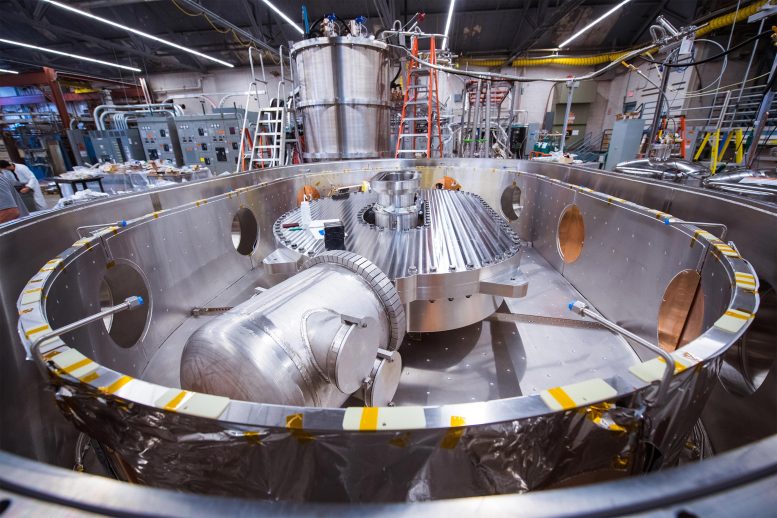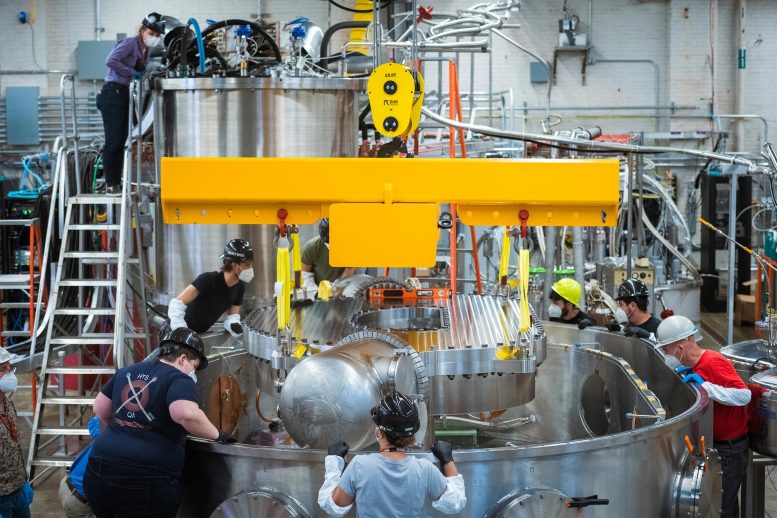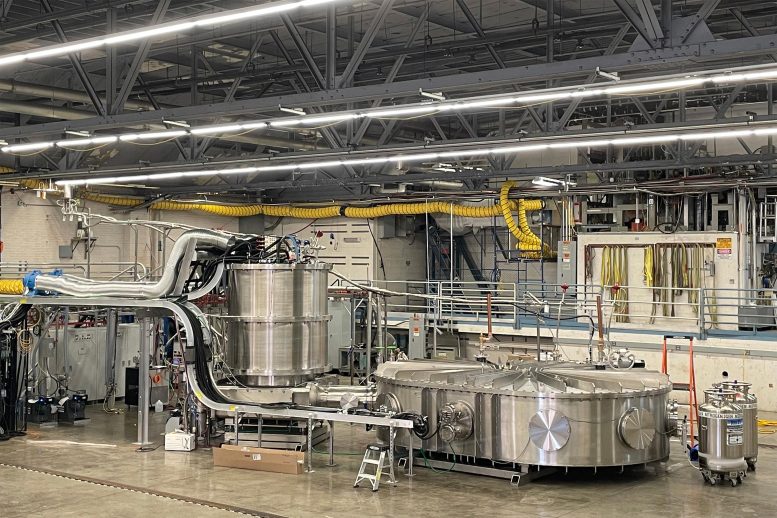
In MIT’s Plasma Science and Fusion Center, the new magnets achieved a world-record magnetic field strength of 20 tesla for a large-scale magnet. Credit: Gretchen Ertl
Detailed study of high-temperature superconducting magnets built by
But that was far from the end of the process. Over the ensuing months, the team tore apart and inspected the components of the magnet, pored over and analyzed the data from hundreds of instruments that recorded details of the tests, and performed two additional test runs on the same magnet, ultimately pushing it to its breaking point in order to learn the details of any possible failure modes.

A team lowers the magnet into the cryostat container. Credit: Gretchen Ertl
All of this work has now culminated in a detailed report by researchers at PSFC and MIT spinout company Commonwealth Fusion Systems (CFS), published in a collection of six peer-reviewed papers in a special edition of the March issue of IEEE Transactions on Applied Superconductivity. Together, the papers describe the design and fabrication of the magnet and the diagnostic equipment needed to evaluate its performance, as well as the lessons learned from the process. Overall, the team found, the predictions and computer modeling were spot-on, verifying that the magnet’s unique design elements could serve as the foundation for a fusion power plant.
Enabling Practical Fusion Power
The successful test of the magnet, says Hitachi America Professor of Engineering Dennis Whyte, who recently stepped down as director of the PSFC, was “the most important thing, in my opinion, in the last 30 years of fusion research.”
Before the Sept. 5 demonstration, the best-available superconducting magnets were powerful enough to potentially achieve fusion energy — but only at sizes and costs that could never be practical or economically viable. Then, when the tests showed the practicality of such a strong magnet at a greatly reduced size, “overnight, it basically changed the cost per watt of a fusion reactor by a factor of almost 40 in one day,” Whyte says.

The test setup inside MIT’s Plasma Science and Fusion Center. Credit: Gretchen Ertl
“Now fusion has a chance,” Whyte adds. Tokamaks, the most widely used design for experimental fusion devices, “have a chance, in my opinion, of being economical because you’ve got a quantum change in your ability, with the known confinement physics rules, about being able to greatly reduce the size and the cost of objects that would make fusion possible.”
The comprehensive data and analysis from the PSFC’s magnet test, as detailed in the six new papers, has demonstrated that plans for a new generation of fusion devices — the one designed by MIT and CFS, as well as similar designs by other commercial fusion companies — are built on a solid foundation in science.
The Superconducting Breakthrough
Fusion, the process of combining light atoms to form heavier ones, powers the sun and stars, but harnessing that process on Earth has proved to be a daunting challenge, with decades of hard work and many billions of dollars spent on experimental devices. The long-sought, but never yet achieved, goal is to build a fusion power plant that produces more energy than it consumes. Such a power plant could produce electricity without emitting greenhouse gases during operation, and generating very little radioactive waste. Fusion’s fuel, a form of hydrogen that can be derived from seawater, is virtually limitless.

The large team that worked on the magnets was from MIT’s Plasma Science Fusion Center and MIT spinout Commonwealth Fusion Systems. Credit: Gretchen Ertl
But to make it work requires compressing the fuel at extraordinarily high temperatures and pressures, and since no known material could withstand such temperatures, the fuel must be held in place by extremely powerful magnetic fields. Producing such strong fields requires superconducting magnets, but all previous fusion magnets have been made with a superconducting material that requires frigid temperatures of about 4 degrees above SciTechDaily